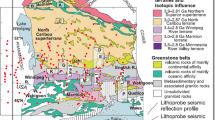Abstract
The problem of quantitative three-dimensional interpretation of the magnetotelluric (MT) data ranks among the most difficult problems in electromagnetic (EM) geophysics. Our paper presents a new rigorous numerical method for MT inversion, based on the integral equations technique. An important feature of the proposed method is the calculation of the Frechet derivative with the aid of a quasi-analytical approximation with an inhomogeneous background. This approach simplifies the algorithm of inversion and requires only a single forward modeling on each iteration. We have also developed a method for a joint inversion of MT and magnetovariational (MV) data. We show in the present paper that the joint inversion of MT impedances and the Wiese-Parkinson vectors can automatically allow for the static shift in the observed data, which is caused by the geoelectric inhomogeneities contained in the near-surface layer.
Similar content being viewed by others
References
D. L. Alumbaugh and G. A. Newman, “Three-Dimensional Massively Parallel Inversion — II. Analysis of a Cross-Well Electromagnetic Experiment,” Geophys. J. Int. 128, 355–363 (1997).
M. N. Berdichevsky and V. I. Dmitriev, Magnetotelluric in the Context of the Theory of Ill-Posed Problems (Soc. Explor. Geophys., Tulsa, OK, 2002).
M. N. Berdichevsky and V. I. Dmitriev V.I., Models and Methods of Magnetotellurics (Springer-Verlag, Berlin, 2008).
M. N. Berdichevsky and M. S. Zhdanov, Advanced Theory of Deep Geomagnetic Sounding, (Elsevier Science & Technology, Oxford, GB, 1984).
S.C. Constable, R. L. Parker, and C. G. Constable, “Occam’s Inversion: A Practical Algorithm for Generating Smooth Models from Electromagnetic Sounding Data,” Geophysics 52(3), 289–300 (1987).
N. G. Golubev and M. S. Zhdanov, “Three-Dimensional Interpretation of Magnetotelluric Data Collected for Mineral Exploration in Voisey’s Bay, Labrador, Canada,” in Proceedings of 2000 CEMI Annual Meeting, Salt Lake City, UT, 2000, pp. 559–594.
N. G. Golubev, M. S. Zhdanov, K. Matsuo, and T. Negi, “Three-Dimensional Inversion of Magnetotelluric Data over Minami-Noshiro Oil Field,” in Proceedings of the Second International Symposium of Three-Dimensional Electromagnetics, University of Utah, Salt Lake City, UT, 1999, pp. 305–308.
A. V. Gribenko and M. S. Zhdanov, “Regularized Focusing Inversion of Marine CSEM Data using Minimum Vertical Support Stabilizer,” in Expanded Abstracts of the 77th SEG Annual International Meeting, San Antonio, TX, 2007, pp. 579–583.
G. W. Hohmann, “Three-Dimensional Induced Polarization and EM Modeling,” Geophysics 40, 309–324 (1975).
G. Hursán and M. S. Zhdanov, “Contraction Integral Equation Method in Three-Dimensional Electromagnetic Modeling,” Radio Sci. 37(6), 1089 (2002).
R. L. Mackie and M. D. Watts, “The Use of 3D Magnetotelluric Inversion for Exploration in Complex Geologic Environments: Potential Pitfalls and Real World Examples,” Eos Transactions, 85 (2004), GP14A-01.
G. A. Newman and D. L. Alumbaugh, 3D EM Modeling and Inversion on Massively Parallel Computers, (Sandia Report, London, 1996).
G. A. Newman and D. L. Alumbaugh, “Three-Dimensional Massively Parallel Inversion—I. Theory,” Geophys. J. Int. 128(2), 355–363 (1997).
O. N. Portniaguine and M. S. Zhdanov, “Focusing Geophysical Inversion Images,” Geophysics 64, 874–887 (1999).
Y. Sasaki, “Full 3D Inversion of Electromagnetic Data on PC,” J. Appl. Geophys. 46(1), 45–54 (2001).
W. Siripunvaraporn, G. Egbert, Y. Lenbury, and M. Uyeshima, “Three-Dimensional Magnetotelluric Inversion: Data-Space Method,” Phys. Earth Planet. Inter. 150, 3–14 (2005).
W. Siripunvaraporn, M. Uyeshima, and G. Egbert, “Three-Dimensional Inversion for Network-Magnetotelluric Data,” Earth, Planets Space 56, 893–902 (2004).
A. N. Tikhonov and V. N. Arsenin, Solution of Ill-Posed Problems (V. H. Winston and Sons, Wiley, New York, 1977).
P. E. Wannamaker, “Advances in Three-Dimensional Magnetotelluric Modeling Using Integral Equations,” Geophysics 56, 1716–1728 (1991).
P. Weidelt, “EM Induction in Three-Dimensional Structures,” Geophysics, 41, 85–109 (1975).
M. S. Zhdanov, Geophysical Electromagnetic Theory and Methods (Elsevier, Amsterdam, 2009).
M. S. Zhdanov, Geophysical Inverse Theory and Regularization Problems (Elsevier Science B.V., Amsterdam, 2002).
M. S. Zhdanov, Theory of Inverse Problems and Regularization in Geophysics (Nauchnyi Mir, Moscow, 2007) [in Russian].
M. S. Zhdanov and S. Fang, “3D Quasi-Linear Electromagnetic Inversion,” Radio Sci. 31, 741–754 (1996).
M. S. Zhdanov and S. Fang, “3D Quasi-Linear Electromagnetic Modeling and Inversion,” in Three-Dimensional Electromagnetics, Ed. by M. Oristaglio and B. Spies (Soc. Explor. Geophys., Tulsa, 1999), pp. 233–255.
M. S. Zhdanov, S. Fang, and G. Hursán, “Electromagnetic Inversion Using Quasi-Linear Approximation,” Geophysics 65, 1501–1513 (2000).
M. S. Zhdanov and G. Hursán, “3D Electromagnetic Inversion Based on Quasi-Analytical Approximation,” Inverse Problems 16, 1297–1322 (2000).
M. S. Zhdanov, A. Gribenko, and M. Cuma, “Regularized Focusing Inversion of Marine CSEM Data Using Minimum Vertical Support Stabilizer,” in Proceedings of the CEMI Annual Meeting, Salt Lake City, UT, 2007, pp. 345–371.
M. S. Zhdanov and G. W. Keller, The Geoelectrical Methods in Geophysical Exploration (Elsevier Science, Amsterdam, 1994).
Author information
Authors and Affiliations
Additional information
Original Russian Text © M.S. Zhdanov, V.I. Dmitriev, A.V. Gribenko, 2010, published in Fizika Zemli, 2010, No. 8, pp. 12–26.
Rights and permissions
About this article
Cite this article
Zhdanov, M.S., Dmitriev, V.I. & Gribenko, A.V. Joint three-dimensional inversion of magnetotelluric and magnetovariational data. Izv., Phys. Solid Earth 46, 655–669 (2010). https://doi.org/10.1134/S1069351310080033
Received:
Published:
Issue Date:
DOI: https://doi.org/10.1134/S1069351310080033




